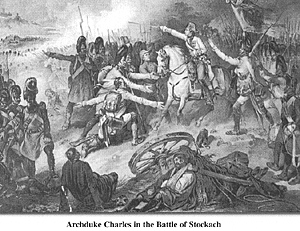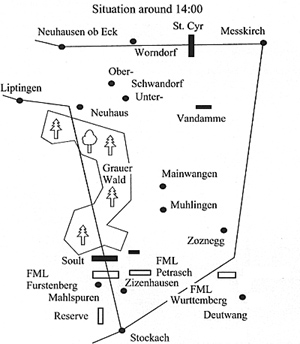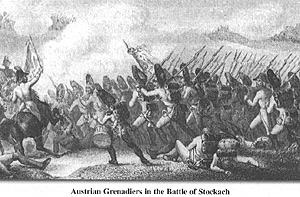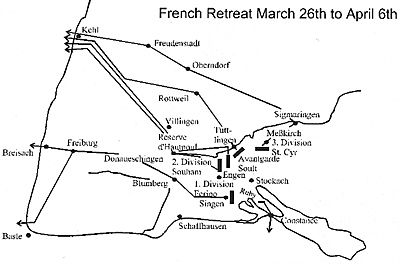Battle of Stockach
25 March 1799
Part 2
The Destruction of 8e Demi-Brigade
and the Austrian Pursuit
by Roland Kessinger, Germany
| |
Archduke Charles in the Battle of Stockach The other infantry (from Soult’s Division) were only to start their advance after the cavalry charge, so as that failed, Soult’s men only suffered light casualties, but it was a different story for 8e DB. Now isolated north of Neuhaus after the French cavalry had retreated, they were quickly encircled by the Austrian Grenadiers and part of IR21. In a brief exchange, Chef de Bataillon Marion was wounded and captured together with 350 of his men, although the rest managed to escape to Neuhausen ob Eck, where they rejoined Soult’s 2nd Division. The Austrian Grenadiers on the left side of the Stockach-Liptingen road could not advance any further from the Homburg Hill towards Liptingen, but the battalions on the right side could make some progress. After 8e DB had been destroyed, the Teschner Grenadier Battalion lowered bayonets and advanced into the forest between Liptingen and Neuhausen ob Eck, pushing the French out into the open ground in front of Neuhausen ob Eck. Once out of the forest, the Grenadier battalion deployed along its edge facing that village. Oberstlt. Teschner sent one company into the village, which had been evacuated by the French, remaining there until by the Austrians in the evening until Teschner was ordered to pull back into the camp near Liptingen. Vandamme against Alex Württemberg
Ansbach Kurassiers stayed on the left wing near Espasingen. Wurttemberg placed his men west of Deutwang and around noon, he could clearly see that the French were making progress on the Austrian right, so he sent some patrols towards Zoznegg and Ursaul. The reports coming back showed that the French had already oc-cupied Muhlingen and Mainwangen – probably troops from GD Vandamme’s force. On his own initiative, Wurttemberg decided to attack them without a specific order from the Army command, as he rightly anticipated that the French were trying to break through to Deutwang, where part of the Reserve artillery was positioned. The first stage was to retake Mainwangen and Muhlingen, for which Württemburg directed a division of 2. Erzherzog Franz Kurassiers on to a hill east of Mainwangen. There they encountered approximately 80 soldiers of IR31 Benjowsky and 40 men of the Wurmser Freikorps, who had become separated from their units during the heavy fighting that morning. Furstenburg, the local sector commander, had directed a Zug of 2. Erzherzog Ferdinand Light Dragoons was also moved up to Zoznegg to join FML Württemburg. Wurttemberg placed the infantry in a forest east of Mainwangen, while he sent the Dragoon Zug and some Kurassier further east of that village. The rest of the division of Erzherzog Franz Kurassiers was pushed forward into a small open area between the forest and the village. As the other four squadrons of Kurassier followed behind slowly, a brief clash prompted the French to abandon Mainwangen and later, Muhlingen also. As the Austrian force advanced, Vandamme concentrated his forces in a small forest called “Birkenhoelzle” north of Mainwangen, but Württemberg was soon attacking again and captured some hussars and some soldiers from 1er Legere. In the interim, Württemberg managed to collect up approximately 600 soldiers from different regiments and several hundred troopers from 1. Merveldt Uhlans, who were the remnants of GM Merveldt’s battered units. The Austrian General now decided to storm the forest to halt Vandamme’s advance altogether. GD Vandamme quickly realised that FML Wurttemberg was concentrating a strong force against 1er Legere (under GB Jardon) in the Birkenhölzle, so he reinforced them with some Chasseurs a Cheval and some light artillery as reinforcements. Wurttemberg knew he had to attack the French in the forest before these reinforcements could reach them. The Austrian infantry was directed to make a frontal assault, while a division of 2. Erzherzog Franz Kurassier tried to get into the rear of the forest from the west. At the same time, the two other divisions of 2. Kurassier charged the Chasseurs a Cheval as they approached and pushed them back, capturing the French commander. As the cavalry engaged on the right flank, the Austrian infantry attacked the forest but were repulsed by 1er Legere, but the cavalry had reached its objective in the rear of the forest from the west. Württemburg could now also attack from the east with the two divisions, which had just driven off the French cavalry. They quickly dealt with the skirmishers, who were now too far distant from their parent units to get support, cutting many down and capturing another sixty. As night fell, the fighting dissipated. FML Württemberg’s Division rested near the Madachhof, while his outposts advanced in the vicinity of Schwandorf with patrols sent towards Messkirch and Krumbach, the latter also being the objective of Vandamme’s “Flanquers”. The French arrived around 10 p.m. and the acted as the rearguard for the later part of St. Cyr’s retreat. St. Cyr’s Outflanking Manoeuvre
Austrian Grenadiers in the Battle of Stockach While Jourdan accompanied Soult towards Stockach, he sent an adjutant to St. Cyr to observe the progress of the outflanking manoeuvre, as St. Cyr marched from Neuhausen ob Eck in the direction of Messkirch. It appears that the right brigade (Walther - 108e DB, 2e Dragoons) marched first along the Neuhausen-Messkirch road, while the left brigade (Legrand - 1er, 8e, 50e DBs, 8e and 10e Chasseurs a Cheval) followed. After more than an hour, now some kilometres to the east, St. Cyr could hear the sound of the heavy fighting between Soult and the Austrian right under FZM Wallis, but continued his march, driving Oberst Keglevich’s weak cavalry units back towards Messkirch. Around 2 p.m., Soult had to start his retreat from his positions near Mahlspuren, so Jourdan sent his Adjutant-Generals Daultanne and Mortier to St. Cyr to order him to hasten 3rd Division’s march towards Messkirch, but to send back one demi-brigade. By the time these Adjutants reached St. Cyr, he was already in Messkirch and so, he decided to send back 8e DB, whose fate would be rather different from the little fighting which the rest of the 3rd Division saw that day. Archduke Charles had however already realised that St. Cyr’s attack was no real threat to his rear, as long as he was able to stop Soult’s and Vandamme’s advance, so he focused on those two columns. Left to face St. Cyr, Oberst Keglevich quickly had to withdraw his weak cavalry force from Messkirch in two directions during the late afternoon. One column followed the main road towards Krauchenwies, while the other went from Messkirch to Kloster Wald to cover the Messkirch to Pfullendorf track. The Austrian cavalry could halt here, as the Austrian counterattack in the Graue Wald and at Liptingen made St. Cyr’s attack useless and forced the French commander to ensure that his Division was not cut off from the main army. During the late evening, he concentrated his troops around Messkirch and after two hours rest, the 3rd Division started to march towards the Danube at 1.30 a.m. on March 26th following the road from Messkirch to Rohrdorf and Engelswies. At daybreak, the Division crossed the Danube at Laiz near Sigmaringen, with Vandamme’s “Flanquers” now guarding his rear. Positions at the End of the Day
On its right were the Tegethoff and Bojakowsky Battalions near the Homburg hill. Next to the main road on the south side near Neuhaus was IR 49 and on the other side in line with them was IR21. Dispersed between Neuhaus and Neuhausen ob Eck were the Teschner and Lippe Grenadier Battalions with FML Riesch’s cavalry in the same area near Neuhaus. The other infantry regiments on the right wing (IRs 1, 31, and 42) were in the second line somewhere between Neuhaus and Stockach. The French still held Liptingen – 25e legere under Mortier garrisoned the village with one battalion at the eastern entrance supported by 5e Hussars and six 4-pounder guns. To the northwest, near the Liptingen-Tuttlingen road, was 53e DB, 17e Dragoons and the remains of the heavy cavalry. To the north of that road was 67e DB under Laval, which around Altental was in contact with the outposts of the 3rd Division, which were probably from 8e DB. The main force, Soult’s advance-guard Division and the Reserve Division under d’Hautpoul camped amongst the forests covering the hills northwest of Liptingen near the Liptingen-Tuttlingen road. With two cavalry regiments, General de Division Klein covered the road from Geisingen-Hattingen to Emmingen ob Eck, based near the latter village. CasualtiesThe Austrian army suffered quite severe losses at Stockach: 15 officers and 403 soldiers killed, 6 officers and 1.964 soldiers wounded and 60 officers and 2.702 soldiers missing, a total of 5,069 men or approximately 10% of the army. It was little different on the French side, where losses totalled 3,654 of approximately 35.000 men, again about 10%. The numbers of losses also reveal which formations took the brunt of the fighting: Ferino’s 1st Division and Ruby’s brigade lost a total of 476 men; Souham’s 2nd Division recorded 1 officer and 66 soldiers killed, 3 officers and 275 men wounded and 5 officers and 103 men missing. St Cyr’s 3rd division suffered 214 dead and wounded plus 416 prisoners. The advance guard under Soult lost 1,257 killed and wounded plus 726 prisoners, while the Reserve Division only had 112 dead and wounded. Thus, it is clear that Soult’s advance guard suffered the most around the Graue Wald. Battle of Stockach: Part 2 25 March 1799
Destruction of 8e Demi-Brigade and the Austrian Pursuit Comments on the Battle Orders of Battle More Battle of Stockach: Part 1 25 March 1799
March 22nd and March 23rd March 24th -- First Clashes March 24th -- Evening Situation Charles' and Jourdan's Plans March 25th First Clashes First Austrian Counterattack Back to Table of Contents -- First Empire #69 Back to First Empire List of Issues Back to MagWeb Master Magazine List © Copyright 2003 by First Empire. This article appears in MagWeb (Magazine Web) on the Internet World Wide Web. Other articles from military history and related magazines are available at http://www.magweb.com |
 Around the same time as the French cavalry action attacked the Austrian Grenadiers, 8e DB had mounted a sweeping attack into the rear of the first Austrian infantry emerging from the Graue Wald from the north, as the last stage of Jourdan’s counterattack, as they would engage the Austrians as they recoiled.
Around the same time as the French cavalry action attacked the Austrian Grenadiers, 8e DB had mounted a sweeping attack into the rear of the first Austrian infantry emerging from the Graue Wald from the north, as the last stage of Jourdan’s counterattack, as they would engage the Austrians as they recoiled.
 While Soult was engaged with almost the entire Austrian right wing in the Graue Wald, General de Division Vandamme had been allotted a specific task. After reaching Neuhausen ob Eck in the morning, his light troops (mainly 1er Legere) were to advance eastwards and then swing south to fall into the rear of the Austrians, hopefully capturing part of the Austrian Reserve artillery. Vandamme’s moved
was halted by FML Prince Alex Württemberg, who that morning had been ordered to take 2. Erzherzog Franz Kurassiers from his brigade on the left wing to the right wing, as there was a surplus of cavalry on the left. His other unit, four squadrons of 11.
While Soult was engaged with almost the entire Austrian right wing in the Graue Wald, General de Division Vandamme had been allotted a specific task. After reaching Neuhausen ob Eck in the morning, his light troops (mainly 1er Legere) were to advance eastwards and then swing south to fall into the rear of the Austrians, hopefully capturing part of the Austrian Reserve artillery. Vandamme’s moved
was halted by FML Prince Alex Württemberg, who that morning had been ordered to take 2. Erzherzog Franz Kurassiers from his brigade on the left wing to the right wing, as there was a surplus of cavalry on the left. His other unit, four squadrons of 11.
 After GM Merveldt’s troops were pushed back from Neuhaus towards Stockach, the French commander-in-chief decided to continue with his general plan and send a strong column into the Austrian rear, using St. Cyr’s 3rd Division and Vandamme’s small brigade (mainly the 1st legere).
After GM Merveldt’s troops were pushed back from Neuhaus towards Stockach, the French commander-in-chief decided to continue with his general plan and send a strong column into the Austrian rear, using St. Cyr’s 3rd Division and Vandamme’s small brigade (mainly the 1st legere).
 After the heavy fighting in the Graue Wald and near Liptingen, the Austrians spent the night in a semi-circle around Liptingen. A few kilometres to the south in the forest was the Sebottendorf Grenadier Battalion.
After the heavy fighting in the Graue Wald and near Liptingen, the Austrians spent the night in a semi-circle around Liptingen. A few kilometres to the south in the forest was the Sebottendorf Grenadier Battalion.